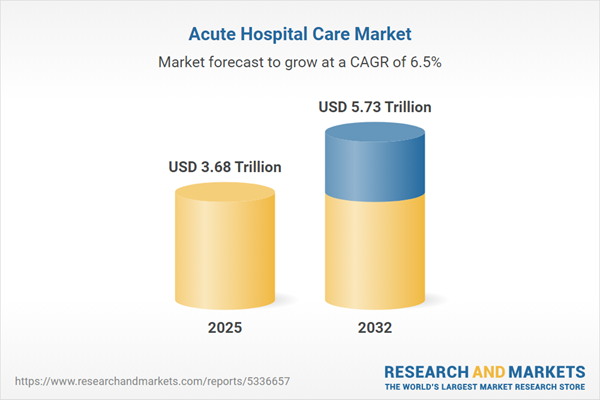Speak directly to the analyst to clarify any post sales queries you may have.
The global acute hospital care market is adapting to rapid regulatory, operational, and technological changes, compelling healthcare leaders to reassess pathways for growth, resilience, and strategic investment.
Market Snapshot: Acute Hospital Care Market Size and Growth Outlook
The acute hospital care market rose from USD 3.45 trillion in 2024 to USD 3.68 trillion in 2025. Sustaining a CAGR of 6.53%, the market is projected to reach USD 5.73 trillion by 2032. This expansion reflects evolving care models, digital integration, and broader patient expectations, positioning acute hospital care as a critical sector for strategic advancement and innovation globally.
Scope & Segmentation
This report delivers detailed forecasts and analysis across multiple dimensions essential to acute hospital care:
- Service Types: Ambulatory surgery, diagnostic services, emergency services, inpatient services, and outpatient care. Specific categories include general surgery, ophthalmology, cardiac diagnostics, imaging, trauma care, critical care, surgical suites, consultation, day surgery, and rehabilitation.
- Specialties: Cardiology (surgical, interventional, non-invasive), neurology (epilepsy, intensive care, stroke), oncology (medical, radiation, surgical), orthopedics (arthroscopy, joint replacement, spine surgery), and general surgery.
- Payor Types: Out of pocket, private insurance, and public insurance.
- Applications: Diagnosis, monitoring, rehabilitation, and treatment.
- Age Groups: Adult, geriatric, neonatal, and pediatric segments, each requiring targeted protocols and infrastructure.
- Regions: Americas (United States, Canada, Mexico, Brazil, Argentina, Chile, Colombia, Peru), Europe, Middle East & Africa (UK, Germany, France, Russia, Italy, Spain, Netherlands, Sweden, Poland, Switzerland, UAE, Saudi Arabia, Qatar, Turkey, Israel, South Africa, Nigeria, Egypt, Kenya), and Asia-Pacific (China, India, Japan, Australia, South Korea, Indonesia, Thailand, Malaysia, Singapore, Taiwan).
- Technology Integration: Digital health, remote monitoring, AI-driven diagnostics, and virtual care models are accelerating real-time care delivery and supporting clinical decisions.
- Companies Analyzed: HCA Healthcare, Community Health Systems, Tenet Healthcare, LifePoint Health, Universal Health Services, Steward Health Care System, Prime Healthcare Services, Prospect Medical Holdings, Quorum Health Corporation, among others.
Key Takeaways: Strategic Insights for Senior Healthcare Leaders
- Changes in payment models and care delivery are driving hospitals toward value-based, outcome-focused contracts and collaborative networks.
- Digital transformation, including the adoption of telehealth and remote monitoring, is influencing both operational workflows and patient engagement strategies.
- Specialties such as cardiology, neurology, oncology, and orthopedics are benefiting from integration of advanced imaging and minimally invasive procedures, which support personalized medicine goals.
- The differentiation of acute hospital care by age group necessitates tailored staffing, facility design, and protocols for adult, geriatric, pediatric, and neonatal populations.
- Portfolio diversification, through strategic acquisitions across diagnostics, robotics, and digital health, is proving essential for resilience and long-term growth.
- Regional variations require custom approaches, as market maturity, regulatory rigor, and local capacity significantly influence acute care strategies in each territory.
Tariff Impact: Navigating New Constraints in U.S. Acute Hospital Supply Chains
The recent introduction of U.S. tariffs on imported medical devices and supplies poses challenges in procurement, inventory, and cost management for healthcare organizations. Procurement teams must now diversify sourcing or enhance domestic partnerships to mitigate financial pressures and supply chain disruptions. These shifts emphasize the value of cross-functional coordination across clinical, financial, and supply chain leadership to support both short-term and long-term institutional objectives.
Methodology & Data Sources
This research is anchored by a blend of qualitative and quantitative analysis. Primary methods included executive interviews and expert panel validation, supplemented by extensive review of regulatory, trade, and peer-reviewed sources. Case studies and data triangulation provided further context to reveal best practices in digital integration, tariff response, and value-based care.
Why This Report Matters
- Empowers senior leaders to anticipate regulatory, tariff, and operational shifts that will impact capital planning and resource allocation.
- Supports portfolio development with insight into specialty trends, digital transformation, and cross-segment opportunities for technology integration.
- Delivers region-specific analyses to help identify growth and risk factors, enabling agile market responses and investment prioritization.
Conclusion
The acute hospital care market is advancing through transformative regulatory, technological, and patient-centered changes. Utilizing insights from this report enables healthcare leaders to confidently respond to evolving market pressures and strategically position their organizations for long-term success.
Additional Product Information:
- Purchase of this report includes 1 year online access with quarterly updates.
- This report can be updated on request. Please contact our Customer Experience team using the Ask a Question widget on our website.
Table of Contents
3. Executive Summary
4. Market Overview
7. Cumulative Impact of Artificial Intelligence 2025
Companies Mentioned
The companies profiled in this Acute Hospital Care market report include:- HCA Healthcare, Inc.
- Community Health Systems, Inc.
- Tenet Healthcare Corporation
- LifePoint Health, Inc.
- Universal Health Services, Inc.
- Steward Health Care System LLC
- Prime Healthcare Services, Inc.
- Prospect Medical Holdings, Inc.
- Quorum Health Corporation
Table Information
| Report Attribute | Details |
|---|---|
| No. of Pages | 197 |
| Published | October 2025 |
| Forecast Period | 2025 - 2032 |
| Estimated Market Value ( USD | $ 3.68 Trillion |
| Forecasted Market Value ( USD | $ 5.73 Trillion |
| Compound Annual Growth Rate | 6.5% |
| Regions Covered | Global |
| No. of Companies Mentioned | 10 |









